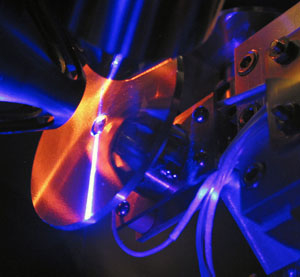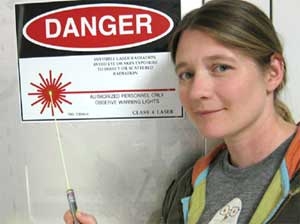From the stars to nuclear forensics
Called Resonance Ionization Mass Spectrometry or RIMS, Knight and LLNL colleague Ian Hutcheon, along with collaborators at Argonne National Laboratory and University of California, Berkeley, have used a laser to ultra-trace samples containing very few atoms of an element. In the test case, Knight was able to identify trace amounts of uranium from a sample of glass taken from the Nevada National Security Site (formerly known as the Nevada Test Site).
Not only that, but the team was able to analyze and identify the sample at the isotopic level faster than traditional methods.
The goal was to identify uranium and plutonium isotopic ratios in a fallout sample. Knight said uranium was quite difficult because when shot with a laser, as opposed to dispersing atoms (as most elements do), uranium breaks up into molecules.
"We had to disrupt the molecular behavior," she said. "The question was can we see plutonium and uranium in a real fallout sample. The answer was 'yes.' It was a high point for three years of work." Typical isotopic analysis requires the sample to be chemically separated and prepared before it can go into a mass spectrometer. But RIMS circumvents the lengthy preparation steps, enabling a rapid data analysis in a couple of hours.
In the case of an above ground nuclear explosion, scientists will want to know the source of the material. Knight said the RIMs technique provides the "physics and chemistry that they are going to want to know about."
"It has a lot of potential, especially with our history in lasers and our expertise in nuclear forensics," she said.
Knight's poster about the project, funded by the Laboratory Directed Research and Development (LDRD) program, recently received a "best poster award" at the annual National Nuclear Security Administration's LDRD Symposium. The poster can be found here .
Contact
Anne M Stark[email protected]
925-422-9799
Tags
Nuclear, Chem, and Isotopic S&TNuclear forensics
Physical and Life Sciences
Lasers and Optical S&T
Lasers
National Ignition Facility and Photon Science
Science
Featured Articles









